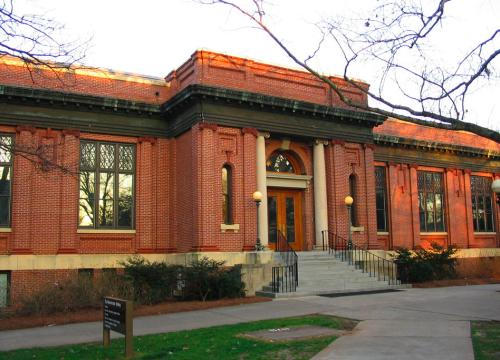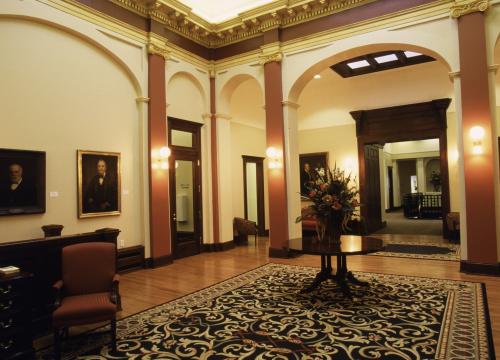Administration Building – UGA 631 (1904, Category 2). During the early 1900s, philanthropist George Foster Peabody donated funds to the university to build a new fireproof building for the school’s library following the renovation of Ivy Hall. Haralson Bleckley was selected as architect. The Beaux-Arts, Neoclassical building they constructed served as the University library until 1953, when the current main library was completed.
The structure was subsequently used as the Georgia Museum of Art, established in 1945 based on the donation of a collection of paintings by Alfred H. Holbrook. In 1982, the Georgia General Assembly designated it the state’s official art museum. The museum has since moved to a new building, and the 1904 structure, now referred to as the Administration building, houses the offices of the President and Vice Presidents of the University.
Administration building is a two-story brick structure with a one-story primary floor level that faces Franklin quadrangle, and a lower ground floor level accessible on the sides and rear. With its large windows, terra cotta detailing, and large copper cornice, Administration building has a dignified exterior.
The building’s brick exterior walls have thin, high quality mortar joints on the principal facade and wider, more common joints on side and rear facades. A number of poor repairs have been undertaken involving both mortar joints that do not match historic joints and the use of sealant smeared over cracks. Open joints in need of repair are visible at the brick and stone parapet as well as at some stone sills. Terra cotta detailing is present within the brickwork, some of which is in need of repair.
New metal windows have been installed throughout the building. The replacement windows are of high quality and replicate the historic appearance of the building. A pair of original wood windows remain on either side of the main entrance as well. The interior of the building has been substantially rehabilitated, although the interior layout appears to remain. The Administration Building retains a high degree of integrity of the exterior and appears to contribute to a National Register-eligible historic district. It is assessed as a Category 2 resource.


